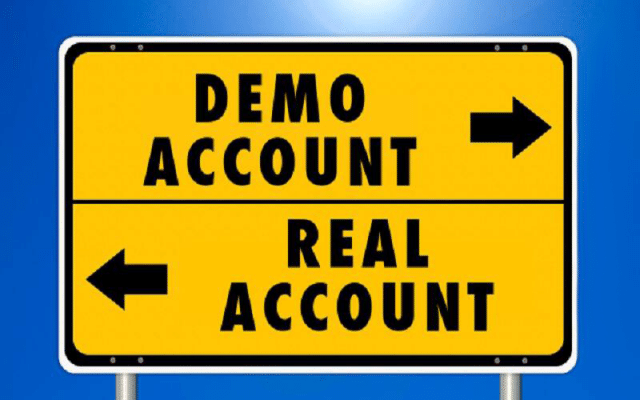Live and demo trading accounts stand widely apart. Despite the fact that both reflect the same chart movements in real-time, from a technical and psychological perspective, they are worlds apart. This article will cover the differences in more detail and provide a few solutions that allow for a better transition from demo to live accounts for new traders.
Technical differences between a demo and live accounts
Live and demo accounts in forex are indeed worlds apart. It’s worthwhile to mention the technical differences between the two. Although if we consider the more significant distinction, it’s the psychology that is the tremendous shift.
Nonetheless, from a technical standpoint, analysts sometimes refer to demo accounts as simulated. While someone looking at the same chart on both a live and demo account will see the exact price movements in real-time, it’s the execution that drastically differs.
Typically, the commission and swap costs remain the same in both settings. For example, if the commission on a one lot EUR/USD trade is $1, it should also be $1 in a live account using the same parameters.
The main technical variations are the spreads and slippage or requotes.
Spreads
Spreads are relatively consistent on demo but can vary widely on the live ones. In a live account, a trader experiences the magnitude of volatility completely different from a demo account. These occasions include when trading sessions overlap, at rollover, high-impact news releases, and just other random erratic times.
In a demo situation, it is unlikely a trader experiences spread widening because the price feeds between the two are not the same. Therefore, someone will not feel the trading cost implication of such events on a demo.
While these things don’t occur all the time on a live account, when they do, the impact is felt.
Slippage
Almost no slippage or requotes in the demo version, but it is present in the live one. Like the previous point, because the price feeds are independent, a trader will not experience slippage or requotes.
Again, though these occurrences should be rare, they still happen from time to time and influence trading costs and execution considerably. In a live account, the broker should connect to multiple liquidity providers for the best prices, an attribute absent on a demo one.
We judge a broker’s execution by their ability to eradicate any lags or delays between the time a client places the order and their ability to fulfill it.
When markets are moving fast, which they sometimes do, there may not be enough time for a trader to receive their original order at the prices they requested, causing the broker to offer a new one (requote).
In most cases, the requote is unfavorable since it is a worse level than what they initially desired. Slippage also occurs for a similar reason. When markets are volatile, the price can change erratically.
Psychological differences between a demo and live accounts
The psychology between the two accounts is the more pertinent dissimilarity. It is a contributor to why many traders have reported being profitable on demo but losing on live.
On a demo account, it is impossible to treat it like real money, which comes with its own emotions. There are no consequences on a demo because a trader is using virtual funds. Although testing a strategy requires following strict rules, it is much harder to follow these on a live account consistently.
In a live setting, someone’s actions are under scrutiny, and their trading decisions have a real influence on their finances, confidence, and mood. Another consideration is most demo accounts have unrealistic starting balances that the average trader would not fund with in real life.
Some do brokers allow traders to set their own amounts, but many will start from $10,000 or even $50,000. This does not mirror what the average person would eventually deposit. In most cases, it is much lower than these figures. Again, psychologically, there is a fundamental shift.
Are there better solutions to forex demo accounts?
It’s crucial to appreciate a brand-new trader must spend at least a full year on a demo account and acquire enough forward-tested results for their trading strategy. Demo is still a necessary step and one that someone mustn’t skip.
Aside from forward-testing, it’s an excellent way to master navigating a trading platform, understanding order types, and just the overall process of getting started.
Making the transition into the live stage is often challenging and finds many traders in vicious cycles of going back to demo and live, strategy-hopping, etc. There are two options to consider to enable a more effortless switch where traders can experience real market conditions while also not giving away too much financially.
No deposit bonus offers
These are promotions given by brokers for new clients to open a trading account without any financial obligation. Additionally, assuming the terms and conditions are reasonable, a trader can make a small withdrawable profit with little or no money out of their pockets.
The benefits of this approach are to gain that experience of a real market and the execution from the broker. Despite usually being a small balance, unlike demo, one should treat it seriously because it technically is real money.
The only drawback of these promotions is the fact they do not provide much flexibility for withdrawals because of the terms and conditions.
Cent or nano accounts
This method may be the better one. Although there is a financial obligation, a trader may accept committing a small amount just to ‘test the waters.’
One of the big mistakes happening for new traders is depositing slightly larger funds that aren’t necessarily disposable income. The same rule of investing money one is prepared to lose still applies to cent accounts.
However, the primary distinction is the amount is small, normally less than $50. Even if, in the worst-case scenario, a trader does not lose it, they should quickly recover it.
Unlike a no deposit bonus, there are no terms and conditions, affording the flexibility of withdrawing at any time. Additionally, you get the necessary real market experience.
Final word
It’s vital to understand the reason for new traders to be profitable on a demo account but fail miserably in a live one. Of course, demo accounts are not entirely useless because someone who’s never traded before cannot just go into the live stage without any experience.
What we should know is transitioning into the live setting means understanding the contrasts mentioned in the article to help us be prepared and have realistic expectations.




